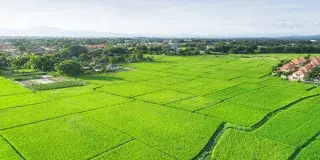Considering the purchase of land for subsequent construction or any other intended use is a process that should be approached with knowledge, about which we usually don't have much information. That's why, at Aliseda Real Estate, we will analyze the different types of plots you can find and the use you can give to each of them.
When defining what a plot is, we refer to land that may or may not be built, regardless of its current condition or applicable regulations.
And, as we already know, in the field of urban planning, this term is used to refer to the legally formed or divided land surface. In this way, the division of land into plots is known as plot division.
List of plot types
Urban plot:
Urban plots are any portion of urban land intended to accommodate a building.
They are also known as buildable plots and differ from the rest by their need for minimal urbanization, such as streets, sidewalks, a sewage system, streetlights, as well as other basic connections like water and electricity.
Within urban plots, we can find consolidated soils, which are located in the city center, and urbanized ones, in new developments with laid streets but without buildings.
Urbanizable plot:
Urbanizable plots are generally non-urbanized lands, meaning they do not need streets, sidewalks, sewage, and water and electricity systems.
These are open to the possibility of urbanization to absorb city growth, as is the case with some lands considered strategic due to their location.
Municipalities may also request the transfer of these plots for the development of public services in the area in question.
Rural plots:
A rural plot is land classified by territorial planning as non-urbanizable. It is synonymous with rural land or non-urbanizable land and is usually categorized based on its protection or use. They are also characterized by a lack of basic urban services such as water or sewage.
The Land and Urban Rehabilitation Law establishes that all territory can be divided into urban and non-urban plots, but it is the regional and municipal regulations that define which parts of the land are of one class or another and their use.
Rural plots can also be categorized based on three criteria: their protection, their condition, and their use.
Types of rural plots based on their protection:
Generic rural plot:
This refers to all rural land that, according to municipal planning, does not deserve specific protection but does require preservation of the urbanization process due to its geographical characteristics or the lack of need in rational urban development.
Protected rural plot:
These are lands where, in addition to the standard prohibition of urbanization, there is a specific restriction due to their scenic or natural value and richness.
Types of rural plots based on their condition:
Non-urbanizable rural plot:
Non-urbanizable rural land is characterized by being completely excluded from urban transformation or construction. Unlike urbanizable land, where municipal law leaves open the possibility of converting it into urban land.
Urbanizable rural plot:
This refers to land that is currently rural but can be converted into urban land according to municipal planning.
Types of rural plots based on their use:
Ordinary use plots:
These plots are mainly intended for productive use, such as agricultural or livestock use, or for conservation, such as forestry use. Urbanization is not considered for these plots, but the creation of buildings or structures for the use and enjoyment of the land based on its purpose is allowed.
Thus, in a rural plot intended for livestock activity, the necessary facilities for animal maintenance and management can be built.
Within this type of plot, we find rural plots for agricultural use intended for irrigation, dry farming, rice fields, fruit trees, olive groves, vineyards, or, as mentioned earlier, for livestock use.
Extraordinary use plots:
The extraordinary use of rural plots consists of exceptional authorization by the administration to carry out constructions other than those provided for in the urban classification of the land.
If you want more information about real estate products, visit our blog now and find other real estate trends, sustainability ideas, home tips, and consultations on places and locations. Follow us on social media to stay updated on our products and services.















